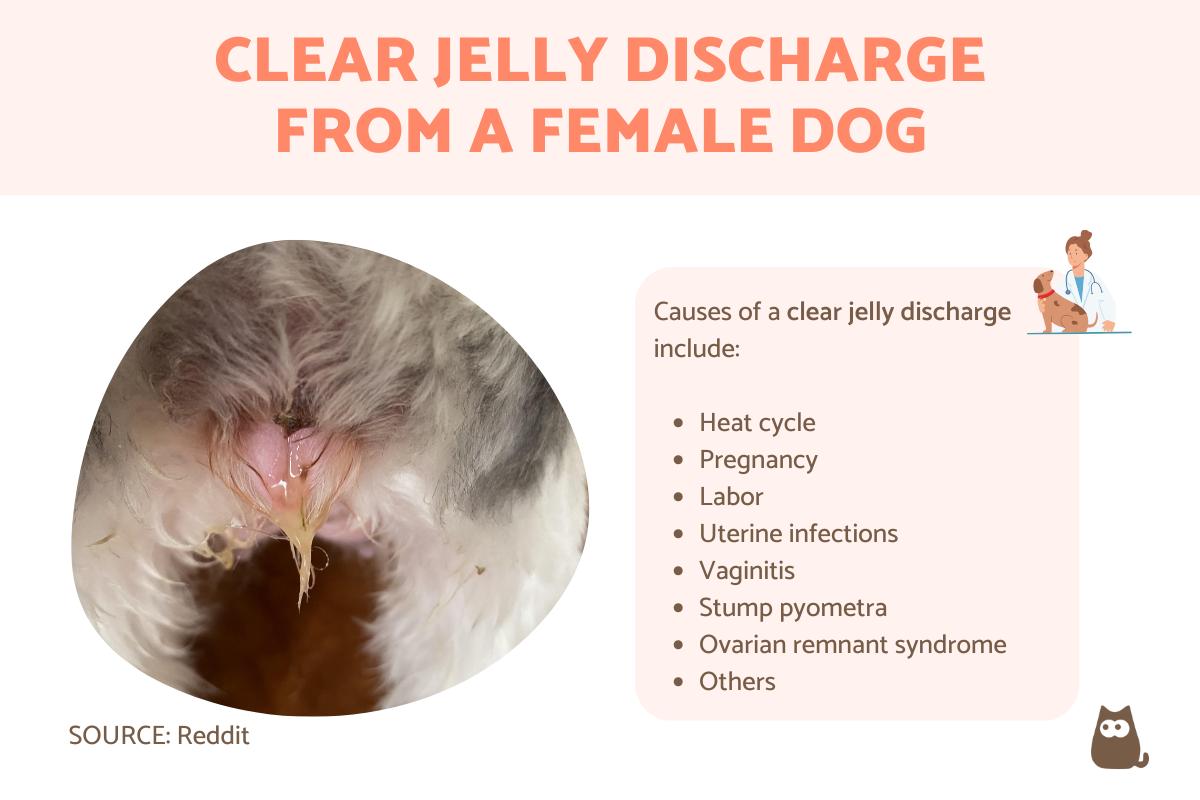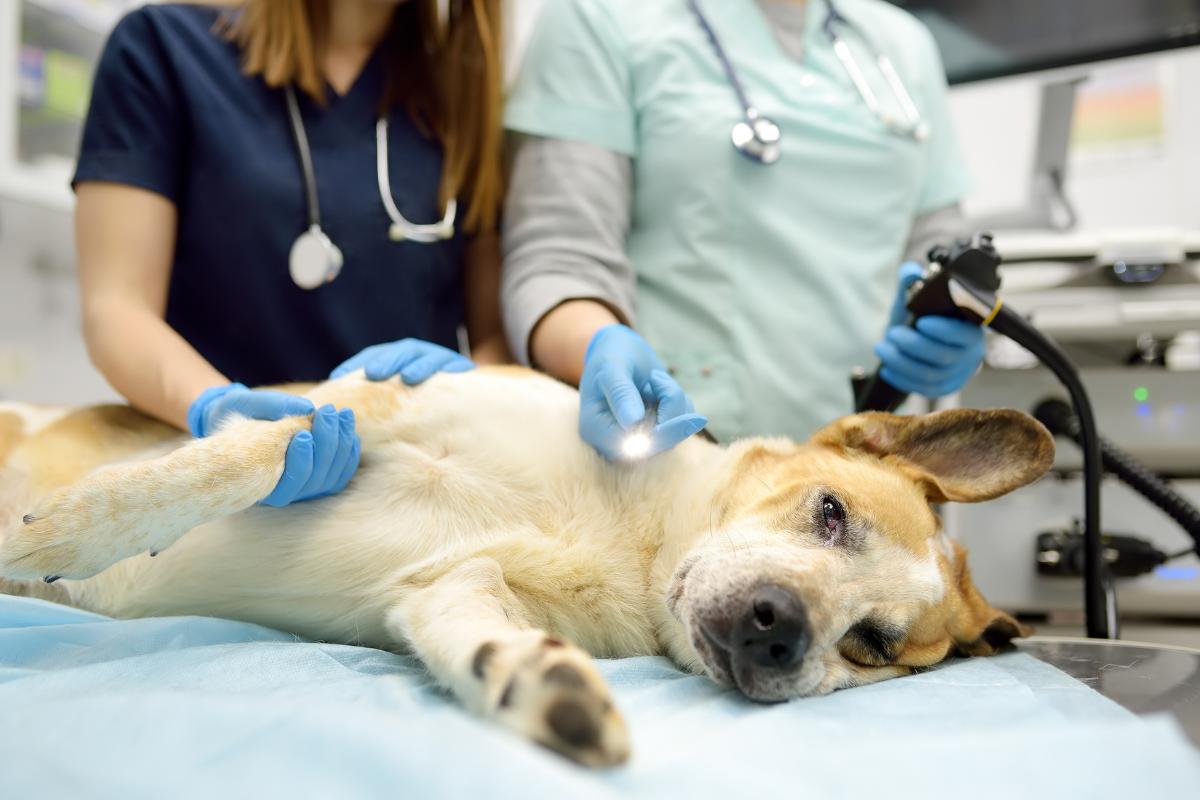Clear Jelly Discharge From a Female Dog



See files for Dogs
The causes of vaginal discharge in a dog can vary according to the reproductive status of the animal. Since vaginal discharge is often a result of sexual activity, it could be related to her heat cycle or even the result of pregnancy. Spayed female dogs should not experience discharge in this same way, suggesting the cause is pathological. Determining the cause will require veterinary consultation. They will look to any concurrent symptoms and the context of the discharge. This includes its color and consistency. These will all inform what tests should be carried out to achieve the correct diagnosis.
When we see clear jelly discharge from a female dog, the type of discharge can help us to know what is wrong. AnimalWised looks at the causes and treatment of this symptom to know what to expect after a veterinary evaluation.
What is discharge in a female dog?
Whether vaginal discharge in a dog is normal will depend on the context. When a dog reaches sexual maturity, hormonal production in the body results in various physical and behavioral changes. In female dogs, this is related to their estrus cycle. This is the time during which they are fertile and able to receive a mate for reproduction.
Commonly known as the heat cycle in dogs, the production of sex hormones during the canine estrus cycle increases drastically. This prepares the female dog's reproductive parts for egg fertilization after she mates with a male. Vaginal discharge is common because the hormones cause swelling of the vulva to attract a mate. It also helps with lubrication during penetration by the male.
Unless they are a breeding dog, veterinarians recommend the animal is sterilized before she reaches sexual maturity. This provides many benefits to both their physical and emotional well-being. It prevents serious diseases associated with the reproductive organs, as well as behavioral problems which are triggered by hormone production. It also helps to reduce the rate of unwanted canine pregnancies which leaves many dogs vulnerable or abused.
Sterilization is normally in the form of ovariohysterectomy. This involves the surgical removal of the uterus and ovaries. Commonly known as spaying in dogs, it is a routine procedure that results in the production of sex hormones being minimal. This means spayed dogs should not experience vaginal discharge in the same way as a sexually intact female.
While complications from ovariohysterectomy are very rare, you can take a look at our article on warning signs after spaying a dog to help ensure they recover properly.
Types of discharge in female dogs
Generally speaking, vaginal discharge in dogs will either be normal or pathological. In some cases, discharge is a response to normal processes occurring in the dog which are informed by hormone production. In others, an aberrant health issue is causing the body to produce discharge as a response. When it is a response to a pathological problem, the discharge is a clinical symptom of the underlying cause.
Looking at the color and consistency of the discharge can help a veterinarian determine the reason for it. Some of the most common types of vaginal discharge in dogs are the following:
- Clear discharge: in these cases, the discharge is most made up of mucus and can be of varying consistency. It can be quite thin and liquid, but it can also be viscous and of a jelly consistency. It can be seen in pregnant dogs both before and after whelping, whether for lubrication or even cleaning purposes. Vaginal mucus provides an important barrier function, so a small amount of clear discharge can indicate a healthy dog.
- White discharge: the vaginal discharge in these cases may be quite thick as the whiteness usually comes from pus. This suggests a bacterial infectious process, but it could also be due to the presence of foreign material. Fungal infection might also cause some whiteish discharge.
- Yellow or green discharge: when the discharge takes on a greenish or yellowish coloration it is almost certainly due to a purulent discharge. This is a result of bacterial infection which can originate in the uterus or vaginal canal, depending on the reproductive status of the animal.
- Red discharge: the redness in this type of discharge is due to blood. More specifically, it is due to fresh blood which suggests the origin is from recent discharge located somewhere in the genitourinary system. The causes can include normal processes such as a small amount being produced during the heat cycle, but it could also be due to something serious such as trauma, infection or cancer.
- Brown or black discharge: in these cases, the redness is usually from old blood. This means it could be residual from the heat cycle, even if they are not currently in estrus. It could also be due to serious issues such as infection or tumors.
In addition to color and consistency, we can look to odor as an indication of the discharge's cause. For example, a yeasty smell can indicate a fungal infection. Other symptoms such as changes in diet, energy levels or even behavior can also help to determine the cause. In some cases, the problem may be severe and cause the dog to go into shock. Regardless of the cause, it is vital the animal receives veterinary consultation.

Clear jelly discharge from a sexually intact female dog
As we have stated, the dog's reproductive status will have a significant bearing on discharge from a female dog. When they are sexually intact, it is more common for some clear discharge to occur. This is usually due either to their heat cycle or pregnancy. However, it is always possible they are experiencing a health problem, so we should never rule this out.
With this context in mind, we see why a sexually intact dog has clear jelly vaginal discharge:
- Heat cycle: if the dog is in her estrus cycle, it is normal for some discharge to occur. Clear, viscous or jelly discharge is most common during the proestrus stage of the dog's heat cycle. This is before the subsequent estrus stage during which the discharge usually contains blood. It is normal and does not indicate a health issue.
- Pregnancy: during a dog's pregnancy, hormonal changes in the body can result in discharge during different stages. It becomes more common during the latter stages of pregnancy, but it should not be large in quantity. It can contain a few drops of blood, but any more can be a sign of miscarriage or other complications.
- Labor: dogs will display various physical and behavioral signs they are about to go into labor. This can include some clear jelly discharge from the vagina. Eventually, we will see a large amount of greenish mucus emerge from the vagina. This is the mucus plug and its ejection signals the beginning of whelping.
- Vaginitis: whether due to infection or irritation, swelling of the vagina can occur. This is often accompanied by mucus. For mild cases, the discharge may be clear, but it can contain blood or pus in more serious infections.
- Uterine infection: in these cases, the infection originates in the uterus. Clear discharge is less common, but it can be a sign that a uterine infection such as pyometra in dogs may be in its early stages of development.
Clear jelly discharge from a spayed female dog
Since they lack a uterus and ovaries, spayed dogs will not enter their heat cycle. They can still produce some thin mucus for barrier protection, but they should not produce vaginal discharge associated with reproductive processes. In these cases, the discharge is usually a sign of a pathological cause. These causes include:
- Vaginitis: inflammation of the vulva can occur, regardless of the dog's reproductive status. In addition to infectious causes leading to mucus discharge, it is possible that foreign bodies from their environment can enter the vagina and cause irritation.
- Urinary tract infection (UTI): infections anywhere in the genitourinary system can cause discharge from the vagina. If they have a mild UTI, some clear discharge may occur.
- Stump pyometra: when a dog is spayed, all of the uterine tissues should be removed. If this procedure is not carried out correctly, the tissue can become infected and result in discharge. Learn more about this process with our article explaining whether spayed dogs can get pyometra.
- Ovarian remnant syndrome: similar to stump pyometra, clear jelly discharge can occur due to some of the ovaries remaining. Since ovary tissue is still present, it can produce sex hormones and cause some of the symptoms associated with the heat cycle.
- Allergies: if some allergen touches the dog's genitals, it can result in an immune response which produces mucus. This can result in a clear jelly discharge.
Very serious infections will usually have more serious symptoms than clear discharge. Blood and/or pus will most likely be present. The same applies to other serious illnesses such as tumors or cancers. Learn more with our related guide as to why a dog is bleeding from her vagina.

What to do if a female dog has clear jelly discharge
If you observe any vaginal discharge in a dog, it is important that you know why it occurs. We should look at the context of this symptom. Sexually intact females can have some discharge during their heat cycle, but we should take them to a veterinarian if the discharge persists after the heat cycle finishes.
We will also need to look for other symptoms which may indicate a health problem. If the discharge continues for more than 24-48 hours, we should take them to a veterinarian. If we see the dog starts to become lethargic, loses appetite or even enters a state of shock, we need to take them for examination immediately. Causes of vaginal discharge in dogs can be very serious and even threaten their life.
Treatment will depend on the cause. If it is a bacterial infection, antibiotic treatment will need to be prescribed. Cancers may require surgery or even chemotherapy, depending on the prognosis. Unless there is an important reason not to, the veterinarian will recommend the dog is spayed. This will help prevent some of the serious health problems which are associated with the reproductive organs.
Learn more about what to expect with this procedure in our article on why a dog is bleeding after spay surgery.

This article is purely informative. AnimalWised does not have the authority to prescribe any veterinary treatment or create a diagnosis. We invite you to take your pet to the veterinarian if they are suffering from any condition or pain.
If you want to read similar articles to Clear Jelly Discharge From a Female Dog, we recommend you visit our Reproductive system diseases category.







